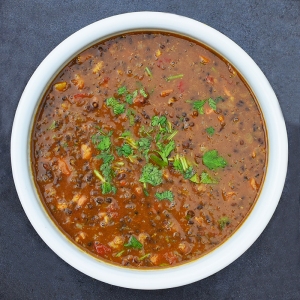
The poll to select recipes for July closed on Tuesday. Here are the four recipes that will be posted on Thursdays this month, in descending order of votes received: Un-Makhni Dal; Baingan Masala; Lamb and Bean Stew; and Lamb Shank Curry with Peanuts and Potatoes. I’m particularly happy to see the two lamb dishes make the cut as they’ve been on the poll for a while. But I’m going to start the month with the top vote-getter: Un-Makhni Dal.
The first thing I will note is that this recipe is very similar indeed to a recipe for kali dal that I posted more than seven years ago. There is only one major ingredient that is added here; the rest differ only in proportions. That major ingredient is smoked ham and it keeps this from being a vegetarian or even a vegan recipe. But, as with my earlier recipe for Smoky White Bean Stew, you can fix that by substituting a smoked vegetarian/vegan ingredient of your choice: tempeh or tofu, most probably. I use whole, unpeeled kali urad dal but you could certainly make this quite successfully with Rancho Gordo’s Black Caviar Lentils, if you have any lying around. Those cook much faster and would obviate the need for a pressure cooker. Of course, if you have time and patience you could also slow cook the kali urad dal—which is something I did during the first year and a half of the pandemic, when time was not in short supply. No matter what route you take, you’re likely to end up somewhere tasty. Continue reading

















